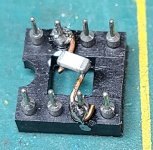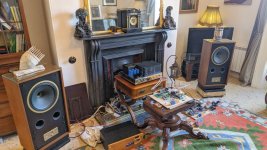Nope.😎
Circuit is grounded through shields of RCA interconect cables to a preamp. RCA connectors are connected to a box. So far no problem noted with static electricity. That would be a problem if someone rubbed the box with something.
Circuit is grounded through shields of RCA interconect cables to a preamp. RCA connectors are connected to a box. So far no problem noted with static electricity. That would be a problem if someone rubbed the box with something.
Last edited:
And dust or if needs to move this box - static can accumulate, no?Nope.😎
Circuit is grounded through shields of RCA interconect cables to a preamp. RCA connectors are connected to a box. So far no problem noted with static electricity. That would be a problem if someone rubbed the box with something.
if I need an optical and coaxial in together with USB amanero? Can I buy a digital reciever board? How to connect them through switch?
Have you used the filter with the IV, and if you did how do you feel it affected the sound.@Brijac - if its a consolation I can't hear any difference between the dip8 and TH version.....
I'll let Fran answer himself. Of course he tried them all.
Which is why it took so long for the Beta test.
But other than sound, you should also consider how much HF content you want to expose your equipment downstream to.
That is not only the eletronics (pre- and power amps), but your tweeter, e.g.
The SMD version has 100kHz Sallen Key by default.
Patrick
Which is why it took so long for the Beta test.
But other than sound, you should also consider how much HF content you want to expose your equipment downstream to.
That is not only the eletronics (pre- and power amps), but your tweeter, e.g.
The SMD version has 100kHz Sallen Key by default.
Patrick
Well, it's a prototype, it's used to test everything, it won't stay there. I primarily tested AK4113 and JLS. It all falls apart and goes to Miro AD1865. The Pavouk AD1865 with one small power supply becomes a Bluetooth only DAC.And dust or if needs to move this box - static can accumulate, no?
if I need an optical and coaxial in together with USB amanero? Can I buy a digital reciever board? How to connect them through switch?
AK4113 board have I2S output, I2S input, two SPDiF inputs and TOSLINK input. JLS is connected to I2S input. I2S output is connected to AD1865.
Just a brief note. It's interesting how much the styling/industrial design of other home electronics devices echoed that of costly home stereo components of that time, the mid-late1970's. For example, that Atari game console, and especially this top-of-the-line Cobra 2000 GTL Citizen's Band radio Basestation transceiver.I have a box to refurbish....
I'm currently using Miro's 1862 DAC with a sparkos descrete opamps with no filter with a Pass DIY Sony VFET and Salas pre feeding full range back loaded horns using Jordan Eikona drivers. So far this setup sounds very good with no indication of problems. But I would like to build another Miro DAC for use in a system that uses a 3 way speaker hence concerns with tweeter and my interest in the filter. The bottom line is that I'll just build it and find out for myself.I'll let Fran answer himself. Of course he tried them all.
Which is why it took so long for the Beta test.
But other than sound, you should also consider how much HF content you want to expose your equipment downstream to.
That is not only the eletronics (pre- and power amps), but your tweeter, e.g.
The SMD version has 100kHz Sallen Key by default.
Patrick
Far be it for me to dissuade someone from building another miro dac, but a few changes can make your current board (or the new one) more flexible. Sockets for Riv (R8, R9) and moving Civ (C31, C36) to a DIP socket lets you experiment with different components or remove them when using an output stage like XEN.
Then you can have fun comparing different output stages with all other variables held constant.
Then you can have fun comparing different output stages with all other variables held constant.
Attachments
I'll take your advice with my next build since I have the boards and DAC chips in hand. I have my first build nicely boxed up and don't want to mess with a good thing.Far be it for me to dissuade someone from building another miro dac, but a few changes can make your current board (or the new one) more flexible. Sockets for Riv (R8, R9) and moving Civ (C31, C36) to a DIP socket lets you experiment with different components or remove them when using an output stage like XEN.
Then you can have fun comparing different output stages with all other variables held constant.
Honestly, I couldn't hear a difference with no filter (other than Civ/Riv) compared to 25kHz and 100kHz S&K filters. But that may be my ears, or my speakers (stacked quad 57s) which probably only go to 18khz anyway. In the end I used the 25kHz filter to limit any high frequency hash running through the system. The power amp I'm using has quite high bandwidth, so I thought it no harm to limit the highs. There is no loss of "sparkle", soundstage or high frequencies to these ears/system at least.
Today I listened to the TH FC Cen IV at a friends place - Tannoy Cheviots, Jadis DA88, and Miro DAC with FC CEN IV and my 3a5 DHT stage. The DHT has been the top of the pile of all the IV stages I've listened to so far.... but the FC CEN IV is maybe edging that out now. It has that bit more tight bass, more resolution, space and dynamics.
Of all the IV stages I've listened to, its the one I would recommend anyone to make. And, if you currently are using op-amps (I did not test discrete opamps like Sparko/Burson etc) then this is such a large jump in sonic quality.
Today I listened to the TH FC Cen IV at a friends place - Tannoy Cheviots, Jadis DA88, and Miro DAC with FC CEN IV and my 3a5 DHT stage. The DHT has been the top of the pile of all the IV stages I've listened to so far.... but the FC CEN IV is maybe edging that out now. It has that bit more tight bass, more resolution, space and dynamics.
Of all the IV stages I've listened to, its the one I would recommend anyone to make. And, if you currently are using op-amps (I did not test discrete opamps like Sparko/Burson etc) then this is such a large jump in sonic quality.
I will try newclassd mk2 ulti, sparkos, burson v6 classics. Then when budget allows i'll participate in next GB for it, and give it a try. Maybe we can get organized again for dip8 adventure again 🤞😁 Beauty is there are going to be quite a few of miro's pcm63p dacs in serbia, so there can be A/B testing.
Maybe we can get organized again for dip8 adventure again
It is foremost limited by unobtainium SMD JFETs that we can / cannot get.
Then they need to be curve traced to proof to be genuine.
Then you need someone brave enough to match 500 devices of 5 different types again.
I would not count on it, however disappointing.
Through hole version is "only" limited by matched Toshiba's.
Easier to get those, in comparison.
Patrick
Last edited:
SS3601? Are they install like ordinary opamps without change schematic on Dac board? Are they better than LM6171? I think 6171 is fast and can get self-excited (I was heard about that)I'm currently using Miro's 1862 DAC with a sparkos descrete opamps with
EDIT - just to be clear on the post above - we compared the FC CEN IV with the Pedja Rogic discrete diamond IV stage (not using something like that as a buffer after the FC CEN IV). Apologies for any confusion caused.
the standard ayaII opa ?EDIT - just to be clear on the post above - we compared the FC CEN IV with the Pedja Rogic discrete diamond IV stage (not using something like that as a buffer after the FC CEN IV). Apologies for any confusion caused.
Nice Patrick look like that you are the only one and me ...that do not want expose to digital gremlinsI'll let Fran answer himself. Of course he tried them all.
Which is why it took so long for the Beta test.
But other than sound, you should also consider how much HF content you want to expose your equipment downstream to.
That is not only the eletronics (pre- and power amps), but your tweeter, e.g.
The SMD version has 100kHz Sallen Key by default.
Patrick
- Home
- Source & Line
- Digital Line Level
- DAC AD1862: Almost THT, I2S input, NOS, R-2R


